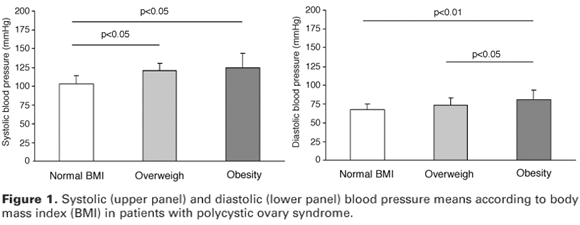As there is controversy about the prevalence of hypertension in patients with polycystic ovary syndrome (PCOS) and, up to the present moment, no studies have evaluated the impact of body mass index (BMI) on blood pressure levels (BP) in these patients, we studied retrospectively sixty-nine patients with PCOS, with BMI of 29.0 ± 6.7 kg/m² and aged 25.6 ± 5.6 yr, subdivided into three groups according to BMI (normal, overweight and obese) and evaluated regarding BP (mercury sphygmomanometer), basal hormonal profile, fasting glucose, and insulin sensitivity (HOMA-IR). Mean systolic blood pressure (SBP) and diastolic blood pressure (DBP) were normal (118.1 ± 17.0 and 74.7 ± 11.5 mmHg, respectively), with a hypertension prevalence of 20.3%. Of these patients, 78.6% were obese and 21.4% were overweight. When the groups were compared according to BMI, a significant increase in SBP and DBP was observed (higher in overweight and obese patients for SBP and higher in obese for DBP), as well as a significant progressive increase in glucose, insulin, homeostatic model assessment, and a significant progressive decline in LH levels. When the patients were subdivided as normotensive or hypertensive, a significant difference was observed only for BMI (28.2 ± 6.1 and 34.7 ± 8.6 kg/m², respectively; p = 0.007). In conclusion, we observed a significant and progressive impact of BMI on blood pressure levels in our patients with polycystic ovary syndrome.
Polycystic ovary syndrome; Blood pressure levels; Hypertension; Body mass index



